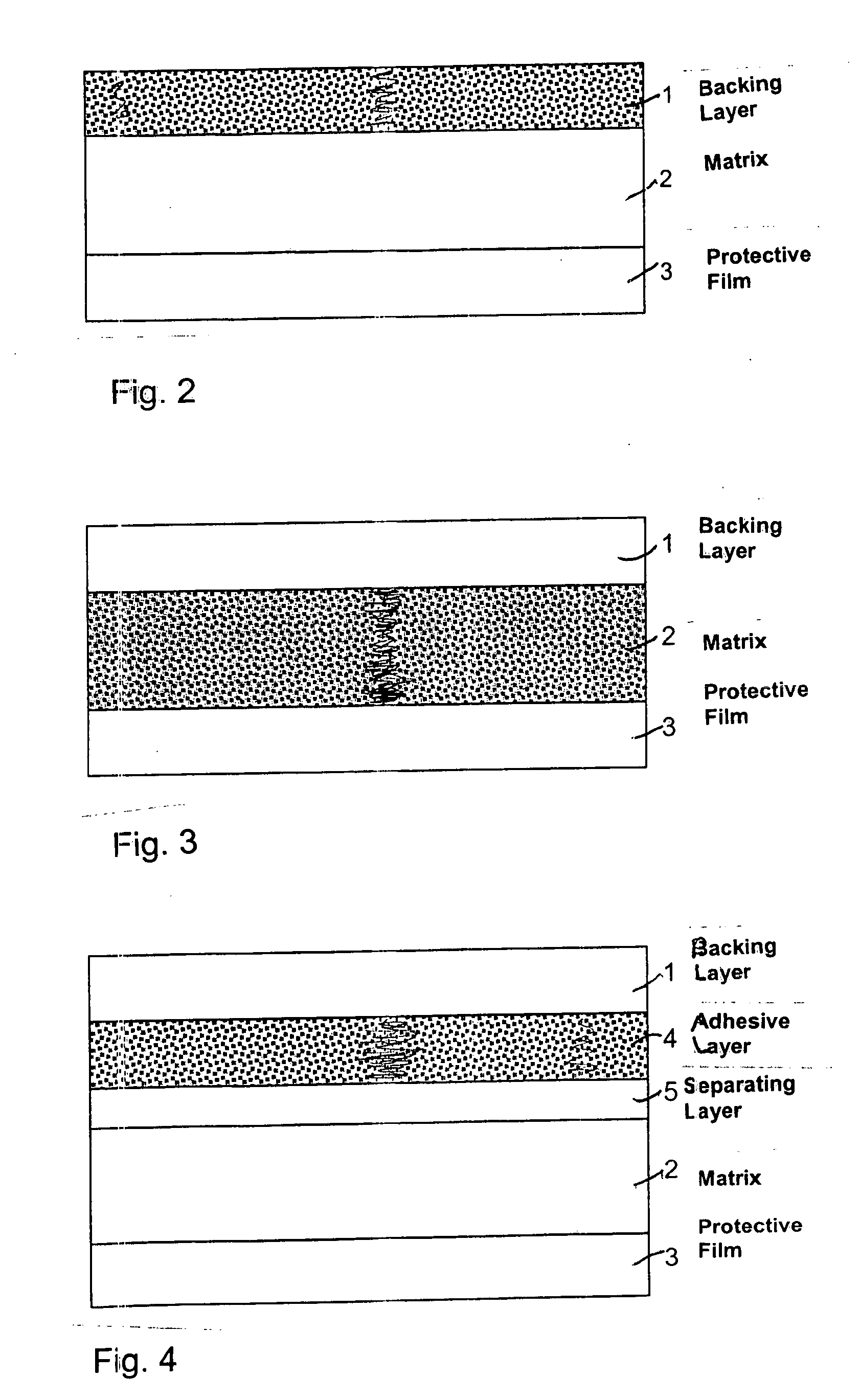Solid transdermal therapeutic system with UV absorber
a transdermal therapeutic system and absorber technology, applied in the direction of biocide, bandages, heterocyclic compound active ingredients, etc., can solve the problems of incomplete protective effect of the added uv absorber for the active ingredient, inability to provide reliable photoprotection, and difficulty in coloring of highly flexible plastic films, etc., to achieve the effect of increasing the protective effect of the active ingredien
- Summary
- Abstract
- Description
- Claims
- Application Information
AI Technical Summary
Benefits of technology
Problems solved by technology
Method used
Image
Examples
example 1
[0037] Two formulations (1 and 2) of a photosensitive active ingredient from the progestogens were prepared. Formulation 2 comprises an adhesive layer 4 and a separating layer 5, and the adhesive layer comprises 2.5% by weight of a UV-absorbing substance from the hydroxyphenyltriazine compounds. Formulation 1 has no adhesive layer and no separating layer. Formulation 1 serves as comparative formulation. Both formulations comprise an active ingredient-containing matrix 2 with a photosensitive progestogen and are equipped with a backing layer 1 of polyethylene, resulting in a TTS in each case. Formulation 2 has the following composition:
[0038] 1. Active ingredient-containing matrix: [0039] 1.9% progestogen [0040] 98.1% polyisobutylene-based adhesive;
[0041] 2. Adhesive layer: [0042] 3% Tinosorb®S [0043] 97% polyisobutylene-based adhesive.
Tinosorb®S (from Ciba, Lampertheim) is a UV absorber of the hydroxyphenyltriazine class.
[0044] To investigate the photo-protective effect, both f...
example 2
[0047] The formulations of example 2 have a photosensitive active ingredient from the progestogens, and in each case an adhesive layer and separating layer. The separating layer in each of these formulations consists of polyethylene terephthalate (Hostaphan®1 from Mitsubishi Polyester, Wiesbaden). Each formulation has the following composition: [0048] 1. Active ingredient-containing matrix
[0049] 1.9% progestogen
[0050] 98.1% polyisobutylene-based adhesive; [0051] 2. Adhesive layer 1 and 2:
[0052] 2.5% Tinosorb®S
[0053] 97.5% polyacrylate-based adhesive.
example 3
[0054] The formulations of example 3 have a photosensitive active ingredient from the progestogens, and in each case two adhesive layers and separating layers. The separating layers in each case consist of polyethylene terephthalate (Hostaphan®1 from Mitsubishi Polyester, Wiesbaden). These formulations each have the following composition: [0055] 1. Active ingredient-containing matrix:
[0056] 1.9% progestogen
[0057] 98.1% polyisobutylene-based adhesive; [0058] 2. Adhesive layer 1 and 2:
[0059] 3% Tinuvin®400
[0060] 97% polyacrylate-based adhesive.
Tinuvin®400 (from CIBA, Lampertheim) is a UV absorber of the hydroxyphenyltriazine class.
PUM
| Property | Measurement | Unit |
|---|---|---|
| Fraction | aaaaa | aaaaa |
| Fraction | aaaaa | aaaaa |
| Thickness | aaaaa | aaaaa |
Abstract
Description
Claims
Application Information
 Login to View More
Login to View More - R&D
- Intellectual Property
- Life Sciences
- Materials
- Tech Scout
- Unparalleled Data Quality
- Higher Quality Content
- 60% Fewer Hallucinations
Browse by: Latest US Patents, China's latest patents, Technical Efficacy Thesaurus, Application Domain, Technology Topic, Popular Technical Reports.
© 2025 PatSnap. All rights reserved.Legal|Privacy policy|Modern Slavery Act Transparency Statement|Sitemap|About US| Contact US: help@patsnap.com


